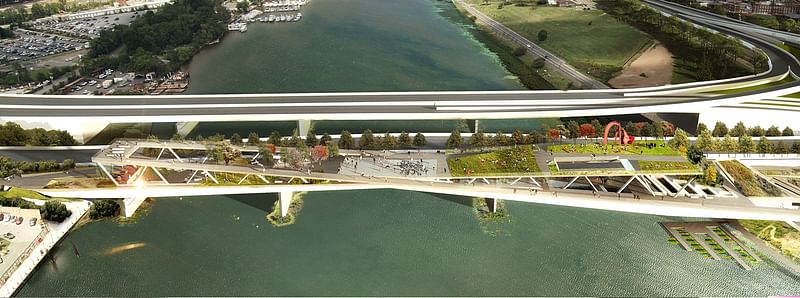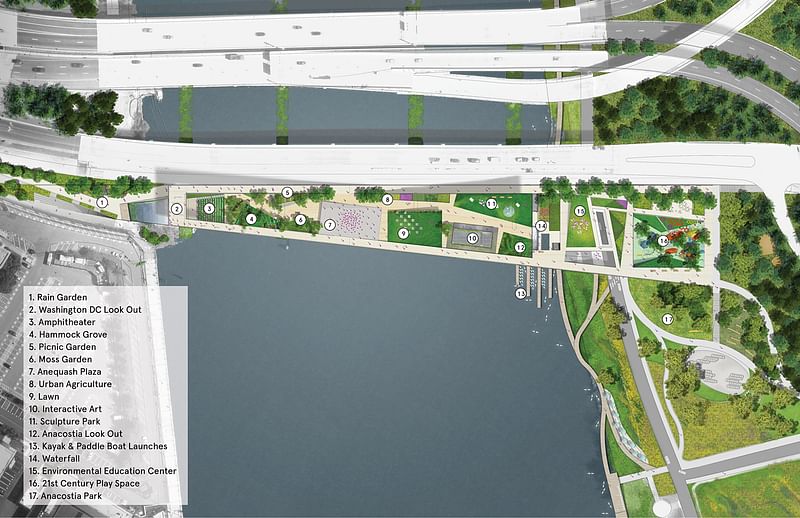OMA and OLIN Studio to design new 11th Street Bridge Park in D.C.
By Bustler Editors|
Wednesday, Oct 15, 2014

Related
OMA and OLIN Studio have been selected to design the new 11th Street Bridge Park in Washington D.C. The competition was held as part of the 11th Street Bridge Park project initiative, which will transform an old freeway bridge into D.C.'s first elevated park.
From the six shortlisted teams in phase one of the nationwide competition, and down to four finalists, OMA + OLIN won the competition with their proposal, "Anacostia Crossing."
The three finalist teams included Balmori Associates/Cooper, Robertson & Partners; Stoss Landscape Urbanism/Höweler + Yoon Architecture; and Wallace Roberts & Todd/NEXT Architects.
Read about the winning proposal in full detail below.
Anacostia Crossing
by OMA + OLIN
"Our design for the 11th Street Bridge Park—the Anacostia C rossing—is a place of exchange. The park at Anacostia Crossing will connect two historically disparate sides of the river with a series of outdoor programmed spaces and active zones that will provide an engaging place hovering above, yet anchored in, the Anacostia River. To create this place—more destination than eleva ted thoroughfare—we have designed the bridge park as a clear moment of intersectio n where two sides of the river converge and coexist. Anacostia Crossing will offer layered programs, presenting a new neighborhood park, an after- hours destination for the nearby workforce, a retreat for residen ts and a territory for tourists to explore.
Paths from each side of the river operate as springboards—sloped ramps that elevate visitors to maximized look out points to landmarks in either direction. Extending over the river, the Anacostia paths join to form a loop, embracing the path from the Navy Yard side a nd linking the opposing banks in a single gesture. The resulting form of the bridge creates an iconic en counter, an “X” instantly recognizable as a new image for the river.
While the bridge is a unique and iconic structure, its character and e ssence are rooted in making this river landscape accessible to the community. Through programmed acti vities the bridge will showcase the region’s unique cultural and natural history. To encourage visitors to spend time on the bridge and neighboring communities throughout the year, amenities for comfort and refreshment (restrooms and food), mitigation of climate extremes (shade and warmth), and opportunities for seasonal programming are provided along the entire length of the bridge. The bridge provides a gateway to events with strong roots in the adjacent communities.
The intersection point of the two paths shapes the central mee ting point of the bridge—an open plaza that provides a flexible venue for markets, festivals, and theatrical performances held throughout the year. The paths that frame this plaza further enhance the bridge as a hub of activity, providing a sequence of zones designated for play, relaxation, learning and gathering."

"The paths also form elevated platforms on a 5% slope with vi ews to the Anacostia River, the activities on the bridge, and prominent landmarks within Washington DC and Anacostia. These platforms simultaneously provide shade and shelter for the café on the southeast side and the performance space and hammock grove on the northwest side. At each side, a waterfall marks their terminus and reconnects them to the river below. On the east side, this waterfall is linked to an active filtration system that—together with new wetland areas adjacent to the bridge piers— works to actively clean the river around the Anacostia Crossing.
The activated zones and multiple levels of the Anacostia Crossi ng also bring visitors down to the river itself. A series of voids along the bridge provide spaces for play and access down to the river itself. The performance space and café are each partially carved into the body of the bridge, creating intimate zones with views to the waters below. Together, these areas allow visitors to engage the river from multiple vantage points, from above to take in its majesty, or engaging with the waters for boating and recreation."

"The Environmental Education Center will provide a variety o f programs which tell the rivers 400 year history of the River. The Anacostia watershed lost much of its origi nal hardwood forest cover, grassland meadows and tidal wetlands due to the treatment of this landscap e by those that lived here as a commodity and not a valued resource. Anacostia Crossing will be a beacon that illuminates the challenged health of the River as well as highlights the possibl e solutions demonstrated by numerous ongoing efforts to clean the river, build community and educate our next generation of river stewards and engaged citizens. Our design will serve as a catalyst to improve th e ecological integrity of the Anacostia River through demonstration and education on ecosystem enha ncement as well as restoration shoreline plantings making it once again one of our Nation’s greatest waterways.
Anacostia Crossing works to promote the health of the citizens of W ashington DC particularly those who live in Wards 6, 7 and 8 reflecting the communities’ aspirations for a new quality of life. The design builds upon and connects to the existing Anacostia Riverwalk Trails on both sides of the river and creates a new topography for the public to engage and explore. Programma tic elements are also extended in a Phase 2 to provide stepping stones to the heart of Historic Anacostia encouraging residents to explore this new place in the city.
Much like the waters of the nearby Chesapeake Bay estuary, where salt and fresh water mix to create a rich biological diversity, the Anacostia Crossing creates a place fo r sharing the rich cultural diversity of communities on both sides of the river. The full integrat ion of architecture, landscape and infrastructure allows for the creation of a socially sustainable civic experience."
See the three finalist proposals right below.




Share
0 Comments
Comment as :